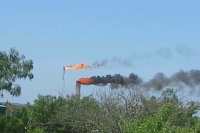Over the past several years, the fossil-fuel industry has been highly adept at publicizing the economic upshots of fracking: royalty checks, decreased prices for oil and gas, profits for investors.
But the industry is far less eager to discuss the hidden costs of the current drilling boom – the longterm price of air and water pollution, the consequences of undermining a nascent renewable energy industry, the harms from accidents when moving and storing all the hazardous waste fracking produces.
Add to that list of hidden costs one that is starting to grab more attention from bankers and the real estate industry: property values and mortgage problems. New research, for example, demonstrates that the vast majority of prospective buyers say they would decline to buy a home near oil and gas drilling.
As millions of Americans sign oil and gas leases granting the right to companies to extract fossil fuels from their land, they are realizing that these documents often conflict with their mortgages, which is leading to all manner of legal and financial headaches, and make it harder to sell homes on land whose oil and gas rights are leased.
Concern about these impacts is spreading in southern states like Texas, Alabama and Florida, according to a survey due for release in the next several weeks from the University of Dever. In northeastern states like Pennsylvania, fracking worries have prompted lenders to begin rejecting mortgage applications due to gas drilling – on neighboring property. In Colorado, real estate brokers describe keeping a long list of sellers in heavily fracked areas, but a paucity of buyers.
Under the terms mortgage buyers like Fannie Mae and Freddie Mac require, “you cannot cause or permit any hazardous materials to be on your property and it specifically references oil and gas,” Greg May, vice president of residential mortgage lending at Tompkins Bank, told American Banker in an interview published Nov. 12. “That alone would make it a problem.”
The repercussions for the American real estate market could be enormous. More than 15.3 million Americans – roughly one out of every 20 people living in the U.S. – now live within a mile of an oil or gas well that was drilled since 2000, the Wall St. Journal recently reported.
And that may be just the tip of the iceberg since shale gas and oil wells require ongoing drilling for them to stay productive. In 2010, for example, Pennsylvania regulators predicted a more than 10-fold increase in shale wells in their state over the next couple decades.



























